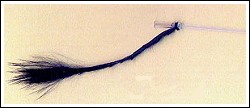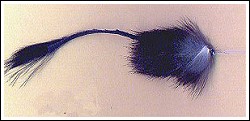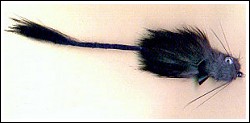|
The Arctic Mouse
by Bob Kenly

Farley Mowat, the renowned
Canadian environmental author, claimed in his book Never Cry Wolf a
large carnivore such as man could survive on mice and to prove this
bizarre theory he spent considerable time during one summer devouring
mice cooked in one form or another. None of this scientific
experimentation seemed to impress the local Arctic inhabitants who knew
long ago wolves, foxes, birds of prey and fish relished the chance to
feast on these protein rich rodents.
Mice patterns in one form of
another have long been a favorite of fly fishermen everywhere especially
the more popular deer hair mouse. Known far and wide as a sure way to
tempt big hungry trout, bass and pike, the deer hair mouse has long
stood the test of time.
During a conversation with
Dennis Harms of Chugiak, Alaska, he complained that most mice patterns
especially the deer hair mouse did not reflect the true nature of a
mouse in the water. Direct observation by him has shown the Arctic mouse
to be a very poor swimmer who struggles hard to barley keep its nose
above the surface thus putting itself in dire danger of either drowning
or being eaten. Dennis's chief complaint about the deer hair mouse, even
though easy to cast, floats too high on the water to accurately imitate
a swimming mouse with most of its bulk beneath the surface.
Reflecting on our conversation I
made several attempts to produce what Dennis described but falling short
of an acceptable solution and shelved the whole idea to a later time. In
a letter to Davy Wotton of Wales I recounted Dennis's story and forgot
the whole thing until Davy wrote a piece in Fly Tyer magazine, which
offered a perfect solution to the mouse dilemma. Davy's idea was really
simple, a mouse constructed of cross cut rabbit or other fur. True, it
will absorb water and be difficult to cast but it does look and act like
a true mouse. Modifying Davy's pattern to a tube fly was easy for me,
finding a source for charcoal gray rabbit skin was harder but a local
shop found some natural skins from Wapsi in Mountain Home, Arkansas and
that's been my source for these skins. Although I use rabbit I'm sure
other locally obtained pelts will do just as well as long as it reflects
a true mouse color.
I've given several samples of
the Arctic Mouse to several friends and they've all reported good
results where ever they tried them, my doctor even catching brown trout
during the daylight hours in Montana which is very unusual as mice tend
to be nocturnal.
Cutting Rabbit Skins Cutting
rabbit skins, especially cross cutting strips can be a frustrating
exercise at best but not having been able to purchase cross cut strips
at the required width and color taking on the job myself was my only
option.
To cut a single strip I lay the
skin on a table with the fur side down and using a straight edge make a
cut on the skin with a single edge razor blade. The trick is not to cut
all the way through the hide but just enough to score the hide. If you
cut all the way through the hide to the fur you'll be cutting the fur
and ruining the strip. Lift the skin and tear it gently along the cut,
if you haven't made the cut deep enough you can gently cut the strip
you've scored with a razor. After the first cut, again lay the straight
edge on the pelt and make another cut so you'll have a 3/8 inch (9.525
mm) wide strip approximately 6 inches (152.4 mm) long. One strip is
usually all that's needed for a one mouse.
Tying the Arctic Mouse Tying
this mouse isn't very difficult, in fact it's probably much easier than
most mice patterns. Think about this, the final product is a totally
panicked rodent swimming for his life not something that's going to be
framed. Even though I'm tying this mouse on a tube it can also be tied
on a suitable long shanked hook.
Step 1. Make a tail
from a piece of dyed rabbit strip, I like leaving a tuft of hair on the
tip, tie it to the tube with thread and cement.

Step 2. Tie on a
piece of the cross cut rabbit strip next to the tail and the fur facing
aft to the hook. Start wrapping the strip slightly overlapping each wrap
to form a thicker body. Tie off with thread and cement wraps.

Step 3. From a
suitable material cut a pair of ears. These can be cut from felt,
chamois etc although I prefer a soft plastic material called "Thin
Skin". Since I like the ears to be laid back over the body which again
gives the appearance of a struggle I cut both ears so they are one
strip. However, if you prefer you can cut both ears separately.

Step 4. Attach the
ears to the body with both laying back.

Step 5. Now it's
time to form the head, again there are several choices such as spun deer
hair, or wool but I like taking the fur from the pelt, placing the under
fur and guard hairs together in a dubbing loop and winding it on the
tube or hook. Trim the hair with a pair of curved scissors to form a
head. Again, it's for a fish, no fine art; close enough is good enough.
The big thing here is to form a dense head.

Step 6. Cement on
eyes, mouse eyes are usually just black dots but I like those small
movable plastic dolls eyes as they add to the, "I going to eaten by a
big fish" panicked appearance. I put my whiskers on right at the nose
and epoxy the thread windings. For whiskers I like a plastic tailing
material called "Fibbets" which comes in colors or can be colored with
marking pens.

Step 7. That's it,
as you can see what looks like a very complicated pattern is really very
simple yet one which very closely resembles what it's supposed to, a
rodent trying to navigate a stream full of danger. When people ask me
how to fish these mice I tell them to cast to as close to the bank as
possible and strip it across the stream just keeping it's head above the
water. After a while the fly will become water soaked and you'll have to
tie on another but despite this finding a more realistic pattern will be
hard to do.
Good Luck, Bob Kenly
© 2000
Bob's
website |